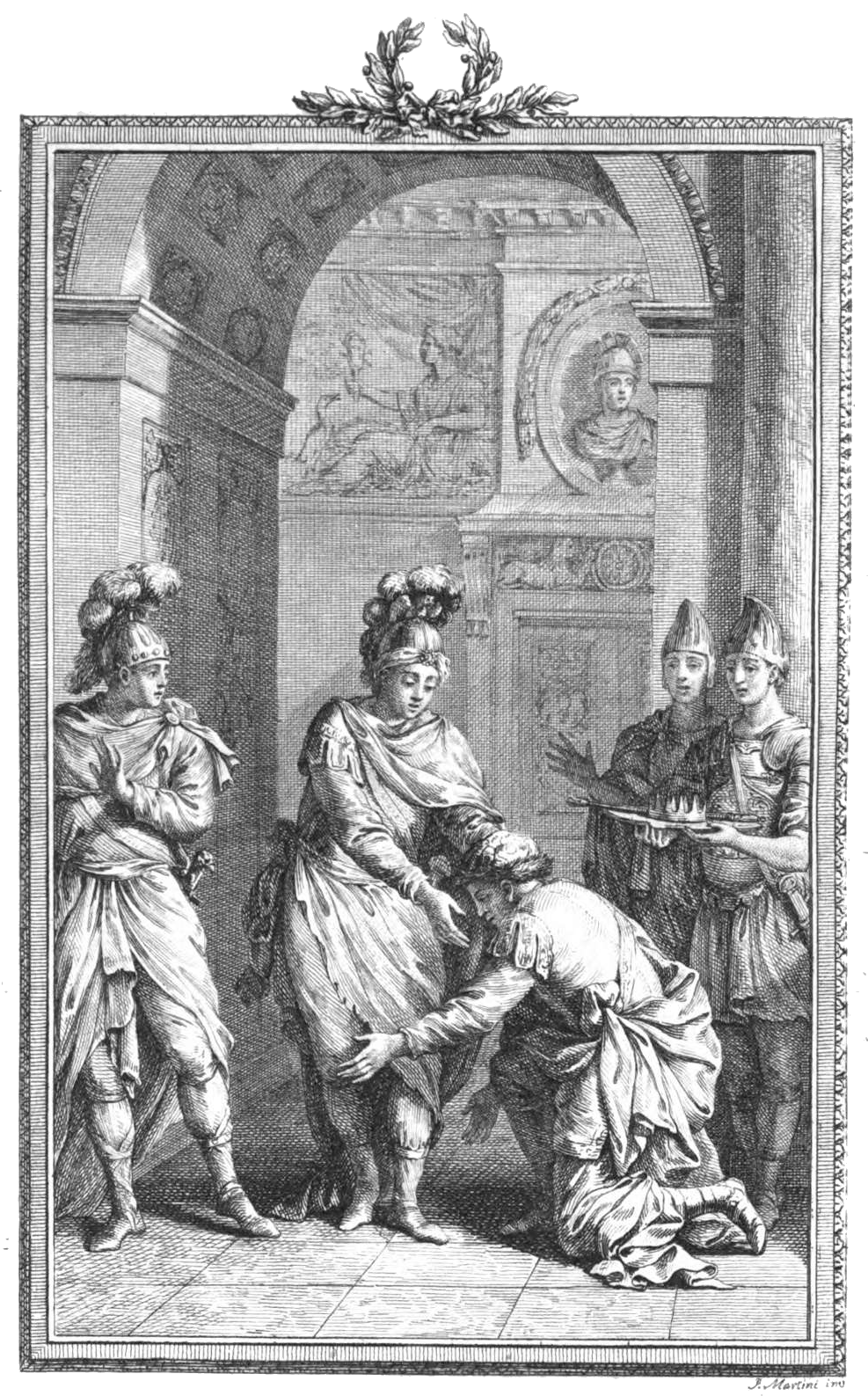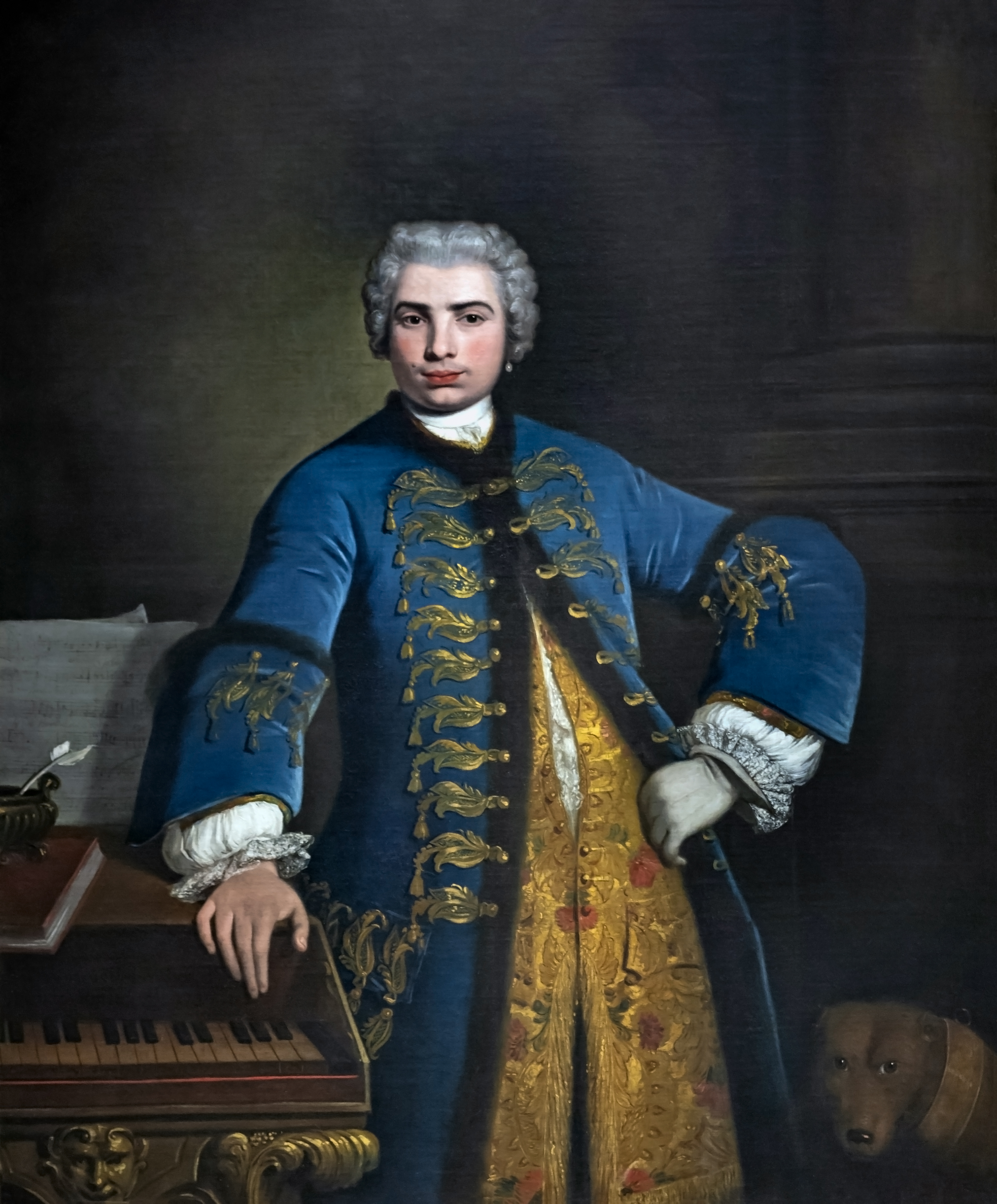|
Demetrio (Metastasio)
''Demetrio'' is an opera libretto in three acts by Pietro Metastasio. It was first performed to music composed by Antonio Caldara on 4 November 1731 during celebrations of the name day of the Holy Roman Emperor Charles VI in Vienna. Different composers later used it when composing operas named ''Alceste'', ''Cleonice'' and ''Demetrio, rè della Siria''. With over fifty settings it was one of Metastasio's most popular works. Action The opera is about the seizure of power by the Seleucid king Demetrius II Nicator after his return from exile. The action takes place in Seleucia. The roles in the opera are: * ''Cleonice,'' Queen of Syria, lover of Alceste * ''Alceste,'' later revealed to be king Demetrio * ''Barsene,'' confidant of Cleonice, secretly in love with Alceste * ''Fenicio,'' councillor, guardian of Alcestes and father of Olinto * ''Olinto,'' councillor, rival of Alceste * ''Mitrane,'' captain of the guard and friend of Fenicio The following plot summary is based on the 17 ... [...More Info...] [...Related Items...] OR: [Wikipedia] [Google] [Baidu] |
Metastasio - Demetrio - Herissant Vol
Pietro Antonio Domenico Trapassi (3 January 1698 – 12 April 1782), better known by his pseudonym of Pietro Metastasio (), was an Italian poet and librettist, considered the most important writer of ''opera seria'' libretti. Early life Metastasio was born in Rome, where his father, Felice Trapassi, a native of Assisi, had taken service in the Corsican regiment of the papal forces. Felice married a Bolognese woman, Francesca Galasti, and became a grocer in the ''Via dei Cappellari''. The couple had two sons and two daughters; Pietro was the younger son. Pietro, while still a child, is said to have attracted crowds by reciting impromptu verses on a given subject. On one such occasion in 1709, two men of distinction stopped to listen: Giovanni Vincenzo Gravina, famous for legal and literary erudition as well as his directorship of the Academy of Arcadians, Arcadian Academy, and Lorenzini, a critic of some note. Gravina was attracted by the boy's poetic talent and personal char ... [...More Info...] [...Related Items...] OR: [Wikipedia] [Google] [Baidu] |
Pierre Corneille
Pierre Corneille (; 6 June 1606 – 1 October 1684) was a French tragedian. He is generally considered one of the three great seventeenth-century French dramatists, along with Molière and Racine. As a young man, he earned the valuable patronage of Cardinal Richelieu, who was trying to promote classical tragedy along formal lines, but later quarrelled with him, especially over his best-known play, ''Le Cid'', about a medieval Spanish warrior, which was denounced by the newly formed ''Académie française'' for breaching the unities. He continued to write well-received tragedies for nearly forty years. Biography Early years Corneille was born in Rouen, Normandy, France, to Marthe Le Pesant and Pierre Corneille, a distinguished lawyer. His younger brother, Thomas Corneille, also became a noted playwright. He was given a rigorous Jesuit education at the ''Collège de Bourbon'' (Lycée Pierre-Corneille since 1873), where acting on the stage was part of the training. At 18 he ... [...More Info...] [...Related Items...] OR: [Wikipedia] [Google] [Baidu] |
Teatro San Giovanni Crisostomo
The Teatro Malibran, known over its lifetime by a variety of names, beginning with the Teatro San Giovanni Grisostomo (or Crisostomo) after the nearby church,Lynn 2005, pp. 101—103 is an opera house in Venice which was inaugurated in 1678 with a production of the premiere of Carlo Pallavicino's opera ''Vespasiano''. By 1683, it had quickly become known as "the biggest, most beautiful and richest theatre in the city"The ''Mercure Gallant'', March 1683, in Lynn, p. 102 and its operatic importance throughout the 17th and 18th centuries led to an even grander description by 1730: :A true kingdom of marvels....that with the vastness of its magnificent dimension can be rightly compared to the splendours of ancient Rome and that with the grandeur of its more than regal dramatic performances has now conquered the applause and esteem of the whole world. Richly decorated, the theatre consisted of five levels of thirty boxes and a large stalls area. However, as an opera house, its success wa ... [...More Info...] [...Related Items...] OR: [Wikipedia] [Google] [Baidu] |
Munich Digitization Center
Munich Digitization Center (German ''Das Münchener Digitalisierungszentrum'' (MDZ)) is an institution dedicated to digitization, Online publication and the long-term archival preservation of the holdings of the Bavarian State Library and other cultural heritage institutions. It was founded in 1997 under the leadership of Mark Brantl. It operates as a unit of the Bavarian State Library. See also * Books in Germany As of 2018, ten firms in Germany rank among the world's biggest publishers of books in terms of revenue: C.H. Beck, Bertelsmann, , , Holtzbrinck Publishing Group, , Springer Nature, Thieme, , and Westermann Druck- und Verlagsgruppe. Overall, "G ... External links Munich Digitization Center {{Authority control German digital libraries Libraries in Munich Early modern printing databases ... [...More Info...] [...Related Items...] OR: [Wikipedia] [Google] [Baidu] |
Giovanni Antonio Giay
Giovanni Antonio Giay (sometimes spelled Giaj; 11 June 1690 – 10 September 1764) was an Italian composer. His compositional output includes 15 operas, 5 symphonies, and a significant amount of sacred music. Life and career Born in Turin, Giay's father, Stefano Giuseppe Giay, was a chemist. His father died when he was 5 years old. In 1710 he entered the Collegio degli Innocenti at the Turin Cathedral where he studied music with Francesco Fasoli. His first opera, ''Il trionfo d'Amore ossia La Fillide'', premiered at the Teatro Carignano during Carnival of 1715. In 1732 he succeeded Andrea Stefano Fiorè as the ''maestro di cappella'' at the royal chapel in Turin at the behest of Charles Emmanuel III of Savoy. He remained in that post until his death 26 years later, after which his son, Francesco Saverio, took over the post from 1764 until 1798. As master of the Cappella Regia, Giay wrote many religious and secular musical and operatic works. His work include ''Don Chisciott ... [...More Info...] [...Related Items...] OR: [Wikipedia] [Google] [Baidu] |
Venanzio Rauzzini
Venanzio Rauzzini (19 December 1746 – 8 April 1810) was an Italian castrato, composer, pianist, singing teacher and concert impresario. He is said to have first studied singing under a member of the Sistine Chapel Choir. He was a cantante soprano at the Socio Accademico of the Accademia di Santa Cecilia in Rome. He studied with Giuseppe Santarelli in Rome. Though unlikely, it has been suggested that Rauzzini may not in fact have been a castrato, but rather had an endocrine condition that prevented his voice from breaking, hence his many affairs as he was thought to be "safe". That said, scholars such as Paul Rice and Brianna Robertson-Kirkland refute this idea. Life Rauzzini was born in Camerino. He made his opera debut in 1765 at the Teatro Valle in Rome portraying one of the female characters in Niccolò Piccinni's opera ''Il finto astrologo''. He sang at the Teatro San Samuele in Venice in 1766, after which he performed at the Bavarian State Opera, Munich Hofoper in 1766� ... [...More Info...] [...Related Items...] OR: [Wikipedia] [Google] [Baidu] |
Senesino
Francesco Bernardi (; 31 October 1686 – 27 November 1758), known as Senesino ( or traditionally ), was a celebrated Italian contralto castrato, particularly remembered today for his long collaboration with the composer George Frideric Handel. Early life and career Senesino was the son of a barber from Siena (hence his stage-name). He joined the cathedral choir there in 1695 and was castrated at the comparatively late age of thirteen. His debut was at Venice in 1707, and during the next decade he acquired a European reputation and, by the time he sang in Lotti's ''Giove in Argo'' in 1717 at Dresden, a commensurately enormous salary. As with many castrati, reports of Senesino's acting were not always positive, to say the least. The impresario Count Francesco Zambeccari wrote of his performance in Naples in 1715: "Senesino continues to comport himself badly enough; he stands like a statue, and when occasionally he does make a gesture, he makes one directly the opposite of what ... [...More Info...] [...Related Items...] OR: [Wikipedia] [Google] [Baidu] |
Farinelli
Farinelli (; 24 January 1705 – 16 September 1782) was the stage name of Carlo Maria Michelangelo Nicola Broschi (), a celebrated Italian castrato singer of the 18th century and one of the greatest singers in the history of opera. Farinelli has been described as having had soprano vocal range and as having sung the highest note customary at the time, C6. Early years Broschi was born in Andria (in what is now Apulia, Italy) into a family of musicians. As recorded in the baptismal register of the church of S. Nicola in Andria, his father Salvatore was a composer and ''maestro di cappella'' of the city's cathedral, and his mother, Caterina Barrese, a citizen of Naples. The Duke of Andría, Fabrizio Carafa, a member of the House of Carafa, one of the most prestigious families of the Neapolitan nobility, honored Maestro Broschi by taking a leading part in the baptism of his second son, who was baptised Carlo Maria Michelangelo Nicola. n later life, Farinelli wrote: "Il Duca d'An ... [...More Info...] [...Related Items...] OR: [Wikipedia] [Google] [Baidu] |
Carestini
Giovanni Carestini (13 December 1700 in Filottrano, near Ancona – 1760 in Filottrano) was an Italian castrato of the 18th century, who sang in the operas and oratorios of George Frideric Handel. He is also remembered as having sung for Johann Adolf Hasse and Christoph Willibald Gluck. Career Giovanni Carestini was born on 13 December 1700 in Filottrano. He was the son of Marco Felice Carestini and Vittoria Costantini. He was baptized two days after his birth by Don Nicola Gentiloni, provost of the Church of Santa Maria Assunta in Filottrano. In that occasion it was given the name Giovanni Maria Bernardino. The godfathers of his baptism were Felice Lancioni and Olimpia Felice Gentiloni, wife of Alessandro Gentiloni, a noble man of Filottrano. Since he was a child he had an exquisite and sweet voice. Carestini's career began in Milan in 1719, patronised at the time by the Cusani family (hence the alternative name Cusanino). He sang for Alessandro Scarlatti in Rome in 1721. ... [...More Info...] [...Related Items...] OR: [Wikipedia] [Google] [Baidu] |
Faustina Bordoni
Faustina Bordoni (30 March 1697 – 4 November 1781) was an Italian mezzo-soprano. In Hamburg, Germany, the Johann Adolph Hasse Museum is dedicated to her husband and partly to Bordoni. Early career She was born in Venice and brought up under the protection of the aristocratic brother composers Alessandro and Benedetto Marcello. Her singing teacher was another composer, Michelangelo Gasparini. For many years in the service of the Elector Palatine, she made her operatic debut at Venice in 1716 in Carlo Francesco Pollarolo's ''Ariodante'', singing in her home city until 1725 in operas by Albinoni, the Gasparini brothers, Giacomelli, Leonardo Leo, Giuseppe Maria Orlandini, the Pollarolos, father and son, and Leonardo Vinci, amongst others. In 1718 and 1719 in Venice she sang alongside Francesca Cuzzoni, later to become her great rival. During this period she also performed several times at Reggio nell'Emilia, Naples and Parma, and at least once in Milan, Modena and Florence. Af ... [...More Info...] [...Related Items...] OR: [Wikipedia] [Google] [Baidu] |




.jpg)

